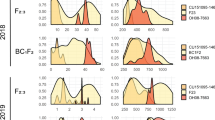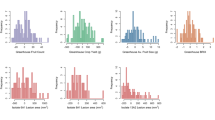Abstract
Late blight (LB), caused by the oomycete Phytophtohra infestans, is one of the most destructive diseases of tomato (Solanum lycopersicum) and other Solanaceae species. Current disease control and prevention strategies are not sufficient to control the disease in tomato. Recent germplasm screening experiments led to the identification of a new source of resistance (PI 270443) in the tomato wild species S. pimpinellifolium. This study was conducted to identify genomic regions associated with LB resistance in this accession. A large F2 population (n = 986) derived from a cross between PI 270443 and a LB-susceptible tomato breeding line (NCEBR-2) was screened for LB resistance using a highly aggressive isolate of P. infestans. Twenty-five of the most resistant and 29 of the most susceptible, but surviving F2 individuals were identified based on disease evaluations conducted in the F2 and F3 progeny populations. The selected individuals were genotyped with 153 DNA markers located across the 12 tomato chromosomes. A selective genotyping approach led to the identification of two genomic regions on tomato chromosomes 1 and 10 associated with LB resistance in PI 270443. Identification of two genomic regions associated with resistance was consistent with a previous estimate of the number of LB resistance genes in this accession. Research is currently underway to fine map the two resistance genes and incorporate them into new tomato breeding lines and hybrid cultivars.


Similar content being viewed by others
References
Abreu FB, da Silva DJH, Cruz CD, Mizubuti ESG (2008) Inheritance of resistance to Phytophthora infestans (peronosporales, pythiaceae) in a new source of resistance in tomato (Solanum sp. (formerly Lycopersicon sp.), solanales, solanaceae). Genet Mol Biol 3:493–497
Ashrafi H, Kinkade MP, Foolad MR (2009) A new genetic linkage map of tomato based on a Solanum lycopersicum × S. pimpinellifolium RIL population displaying locations of candidate resistance ESTs. Genome 52:935–956
Bernatzky R, Tanksley SD (1986) Towards a saturated linkage map in tomato based on isozymes and random cDNA sequences. Genetics 112:887–898
Bombarely A, Menda N, Tecle IY, Buels RM, Strickler S, Fischer-York T, Pujar A, Leto J, Gosselin J, Mueller LA (2011) The sol genomics network (solgenomics.net): growing tomatoes using perl RID C-6580-2009 RID E-8840-2011. Nucleic Acids Res 39:D1149–D1155
Brouwer DJ, St Clair DA (2004) Fine mapping of three quantitative trait loci for late blight resistance in tomato using near isogenic lines (NILs) and sub-NILs. Theor Appl Genet 108(4):628–638. doi:10.1007/s00122-003-1469-8
Brouwer DJ, Jones ES, St Clair DA (2004) QTL analysis of quantitative resistance to Phytophthora infestans (late blight) in tomato and comparisons with potato. Genome 47(3):475–492. doi:10.1139/g04-001
Chunwongse J, Chunwongse C, Black L, Hanson P (2002) Molecular mapping of Ph-3 gene for late blight resistance in tomato. J Hort Sci Biotechnol 77:281–286
Darvasi A, Soller M (1992) Selective genotyping for determination of linkage between a marker locus and a quantitative trait locus. Theor Appl Genet 85:353–359
Ewing EE, Simko I, Smart CD, Bonierbale MW, Mizubuti ESG, May GD, Fry WE (2000) Genetic mapping from field tests of qualitative and quantitative resistance to Phytophthora infestans in a population derived from Solanum tuberosum and Solanum berthaultii. Mol Breed 6:25–36
Foolad MR (2007) Genome mapping and molecular breeding of tomato. Int J Plant Genomics 2007:64358-1–64358-52. doi:10.1155/2007/64358
Foolad MR, Jones RA (1993) Mapping salt-tolerance genes in tomato (Lycopersicon esculentum) using trait-based marker analysis. Theor Appl Genet 87:184–192
Foolad MR, Merk HL, Ashrafi H, Kinkade MP (2006) Identification of new sources of late blight resistance in tomato and mapping of a new resistance gene. In: Ivors K (ed) Proceedings of the 21st Annual tomato disease workshop, North Carolina State University, Fletcher NC, USA, 9–10 Nov 2006, pp 4–7
Foolad MR, Merk HL, Ashrafi H (2008) Genetics, genomics and breeding of late blight and early blight resistance in tomato. Crit Rev Plant Sci 27(2):75–107. doi:10.1080/07352680802147353
Foolad MR, Stoltz T, Dervinis C, Rodriguez RL, Jones RA (1997) Mapping QTLs conferring salt tolerance during germination in tomato by selective genotyping. Mol Breed 3(4):269–277. doi:10.1023/a:1009668325331
Fry WE, Goodwin SB (1997) Re-emergence of potato and tomato late blight in the United States. Plant Dis 81:1349–1357
Gardner RG (1988) NC EBR-1 and NC EBR-2 early blight resistant tomato breeding lines. HortScience 23:779–781
Gardner RG, Panthee DR (2010) NC 1 CELBR and NC 2 CELBR: early blight and late blight resistant fresh market tomato breeding lines. HortScience 45:975–976
Gavino PD, Smart CD, Sandrock RW, Miller JS, Hamm PB, Lee TY (2000) Implications of sexual reproduction for Phytophthora infestans in the United States: generation of an aggressive lineage. Plant Dis 84:731–735
Gisi U, Cohen Y (1996) Resistance to phenylamide fungicides: a case study with Phytophthora infestans involving mating type and race structure. Annu Rev Phytopathol 34:549–572
Griebel T, Zeier J (2008) Light regulation and daytime dependency of inducible plant defenses in arabidopsis: phytochrome signaling controls systemic acquired resistance rather than local defense. Plant Physiol 147:790–801
Judelson HS (1997) The genetics and biology of Phytophthora infestans: modern approaches to a historical challenge. Fungal Genet Biol 22:65–76
Kirk WW, Felcher KJ, Douches DS, Coombs J, Stein JM, Baker KM, Hammerschmidt R (2001) Effect of host plant resistance and reduced rates and frequencies of fungicide application to control potato late blight. Plant Dis 85:1113–1118
Lander ES, Botstein D (1989) Mapping Mendelian factors underlying quantitative traits using RFLP linkage maps. Genetics 121:185–199
Lander ES, Green J, Abrahamson J, Barlow A, Daly M, Lincoln S, Newberg L (1987) MAPMAKER: an interactive computer package for constructing primary genetic maps of experimental and natural populations. Genomics 1:174–181
Lebowitz RJ, Soller M, Beckmann JS (1987) Trait-based analyses for the detection of linkage between marker loci and quantitative trait loci in crosses between inbred lines. Theor Appl Genet 73(4):556–562
Li J, Liu L, Bai Y, Finkers R, Wang F, Du Y, Yang Y, Xie B, Visser R, van Heusden A (2011) Identification and mapping of quantitative resistance to late blight (Phytophthora infestans) in Solanum habrochaites LA1777s. Euphytica 179(3):427–438. doi:10.1007/s10681-010-0340-7
Mayton H, Forbes G, Mizubuti E, Fry WE (2001) The roles of three fungicides in the epidemiology of potato late blight. Plant Dis 85:1006–1012
McDonald BA, Linde C (2002) The population genetics of plant pathogens and breeding strategies for durable resistance. Euphytica 124:163–180
Merk HL, Foolad MR (2012) Parent-offspring correlation estimate of heritability for late blight resistance conferred by an accession of the tomato wild species Solanum pimpinellifolium. Plant Breed 131:203–210. doi:10.1111/j.1439-0523.2011.01898.x
Moreau P, Thoquet P, Olivier J, Laterrot H, Grimsley N (1998) Genetic mapping of Ph-2, a single locus controlling partial resistance to Phytophthora infestans in tomato. Mol Plant Microbe Interact 11(4):259–269
Naerstad R, Hermansen A, Bjor T (2007) Exploiting host resistance to reduce the use of fungicides to control potato late blight. Plant Pathol 56(1):156–166. doi:10.1111/j.1365-3059.2006.01491.x
Navabi A, Mather DE, Bernier J, Spaner DM, Atlin GN (2009) QTL detection with bidirectional and unidirectional selective genotyping: marker-based and trait-based analyses. Theor Appl Genet 118:347–358
Ohyama A, Asamizu E, Negoro S, Miyatake K, Yamaguchi H, Tabata S, Fukuoka H (2009) Characterization of tomato SSR markers developed using BAC-end and cDNA sequences from genome databases. Mol Breed 23(4):685–691. doi:10.1007/s11032-009-9265-z
Panthee DR, Gardner RG (2010) ‘Mountain Merit’: a late blight-resistant large-fruited tomato hybrid. HortScience 45:1547–1548
Park TH, Gros J, Sikkema A, Vleeshouwers V, Muskens M, Allefs S, Jacobsen E, Visser RGF, van der Vossen EAG (2005a) The late blight resistance locus Rpi-blb3 from Solanum bulbocastanum belongs to a major late blight R gene cluster on chromosome 4 of potato. Mol Plant Microbe Interact 18(7):722–729
Park TH, Vleeshouwers VGAA, Huigen DJ, van der Vossen EAG, van Eck HJ, Visser RGF (2005b) Characterization and high-resolution mapping of a late blight resistance locus similar to R2 in potato. Theor Appl Genet 111(3):591–597
Peirce LC (1971) Linkage tests with Ph conditioning resistance to race 0, Phytophthora infestans. Rpt Tomato Genet Coop 21:30
Shtienberg D, Raposo R, Bergeron SN, Legard DE, Dyer AT, Fry WE (1994) Incorporation of cultivar resistance in a reduced-sprays strategy to suppress early and late blights on potato. Plant Dis 78:23–26
Smart CD, Fry WE (2001) Invasions by the late blight pathogen: renewed sex and enhanced fitness. Biol Invasions 3:235–243
Smart CD, Tanksley SD, Mayton H, Fry WE (2007) Resistance to Phytophthora infestans in Lycopersicon pennellii. Plant Dis 91(8):1045–1049. doi:10.1094/pdis-91-8-1045
Tang J, Baldwin S, Jacobs J, Linden CG, Voorrips R, Leunissen J, van Eck H, Vosman B (2008) Large-scale identification of polymorphic microsatellites using an in silico approach. BMC Bioinformatics 9(1):374
Vleeshouwers VGAA, Finkers R, Budding D, Visser M, Jacobs MMJ, van Berloo R, Pel M, Champouret N, Bakker E, Krenek P, Rietman H, Huigen DJ, Hoekstra R, Goverse A, Vosman B, Jacobsen E, Visser RGF (2011) SolRgene: an online database to explore disease resistance genes in tuber-bearing solanum species. BMC Plant Biol 11:116
Voorrips R (2002) MapChart: software for the graphical presentation of linkage maps and QTLs. J Hered 93:77–78
Yu ZH, Wang JF, Stall RE, Vallejos CE (1995) Genomic localization of tomato genes that control a hypersensitive reaction to Xanthomonas campestris pv. vesicatoria (Doidge) dye. Genetics 141:675–682
Zhang L, Lin GY, Niño-Liu DO, Foolad MR (2003) Mapping QTLs conferring early blight (Alternaria solani) resistance in a Lycopersicon esculentum × L. hirsutum cross by selective genotyping. Mol Breed 12:3–19
Acknowledgments
The authors graciously thank Dr. Matthew Kinkade for his help with development of SSR markers and all other Penn State staff and undergraduate students who helped with disease screening and data collection. The authors also are thankful to Dr. Randolph Gardner for providing seeds of control genotypes NC84173, NCEBR-2, NC63 EB, NC870, NC03220 and cultivar New Yorker, to the USDA PGRU for providing the original seed of PI 270443, and to Dr. Seong-Hwan Kim of the Pennsylvania Department of Agriculture for providing original isolates of P. infestans. This research was supported in part by Agricultural Research Funds administered by the Pennsylvania Department of Agriculture, the Pennsylvania Vegetable Marketing and Research Program, and the College of Agricultural Sciences at the Pennsylvania State University.
Author information
Authors and Affiliations
Corresponding author
Electronic supplementary material
Below is the link to the electronic supplementary material.
Rights and permissions
About this article
Cite this article
Merk, H.L., Ashrafi, H. & Foolad, M.R. Selective genotyping to identify late blight resistance genes in an accession of the tomato wild species Solanum pimpinellifolium . Euphytica 187, 63–75 (2012). https://doi.org/10.1007/s10681-012-0729-6
Received:
Accepted:
Published:
Issue Date:
DOI: https://doi.org/10.1007/s10681-012-0729-6




